Oral Minoxidil – Important Information About its Use
Minoxidil has been used for many years to treat the loss of hair on the scalp. The use of minoxidil for hair growth was actually the result of the use of minoxidil for another health condition. Not long after minoxidil was approved in the 1970s as a hypertension treatment, there started to be some reports of patients who began seeing excess hair growth while taking the medication. This side effect was examined, and it led to the development of topical minoxidil and its approval for use by the FDA in 1988. In recent years, the use of minoxidil in a pill format has become much more common and let’s take a look at why oral minoxidil has become so popular.
Oral Minoxidil – Growth in Popularity
 There is starting to be a growing amount of literature and results that supports the use of low dose oral minoxidil for the treatment of hair loss. As recently as 2020, one study reported that thirty men experiencing androgenic alopecia took oral minoxidil. All of the men in the study group enjoyed an improvement in their hair regrowth and 43% of the participants rated their improvements as “excellent.” (It should be noted that this study did not have a control group.)
There is starting to be a growing amount of literature and results that supports the use of low dose oral minoxidil for the treatment of hair loss. As recently as 2020, one study reported that thirty men experiencing androgenic alopecia took oral minoxidil. All of the men in the study group enjoyed an improvement in their hair regrowth and 43% of the participants rated their improvements as “excellent.” (It should be noted that this study did not have a control group.)
There is also some evidence that oral minoxidil can treat more than patten baldness on the scalp of a patient. For example, there is another study that indicates the medication can help in reducing the amount of hair loss that can be the result of telogen effluvium.
Besides the improvements that can be seen on the scalp of a patient, there are also improvements that can be seen in the budget of a patient. There are reports that the generic form of minoxidil can sometimes cost around $3 for thirty pills.
Oral Minoxidil vs. Topical Minoxidil – Is There a Winner?
Many patients who have used topical minoxidil for years are often curious why there is so much talk about the use of oral minoxidil. Besides the growing research showing that oral minoxidil has a similar amount of effectiveness as the topical version, there are other factors at work related to its increase in popularity.
For example, there are some people who simply find it easier to remember to take oral minoxidil once per day as opposed to having to remember to apply minoxidil on the scalp twice per day.
It is also considered to be less messy to use oral minoxidil as the pill version of the medication does not involve greasy hair that comes from placing the medication on the scalp. Applying minoxidil on the scalp can also cause a person to want to wash their existing hair more due to the greasy hair that can sometimes result from the use of the topical version of the medication.
No matter which version of the medication is used by a patient, minoxidil encourages the growth of hair by relaxing blood vessels in the body so the blood is able to flow at an easier rate. In turn, the blood flow contains nutrients which work to stimulate the growth of hair.
Oral Minoxidil – Is it Safe to Use?
One of the main differences that patients should know between topical minoxidil and oral minoxidil is that the topical form has been approved by the FDA for the treatment of hair loss. However, the oral/tablet form has not secured its final approval yet from the FDA.
In other words, minoxidil in the pill form is currently prescribed to patients as an “off label” medication for hair loss. Having said that, this does not mean that the use of oral minoxidil is not safe for patients. It simply means the oral form of the medication has not been specifically studied by researchers in clinical trials regarding the treatment of androgenetic alopecia.
Patients interested in oral minoxidil should know about some of the possible side effects of its use. A few of the possible side effects include:
- Headache
- Fast/Racing heartbeat
- Light amount of hair shedding (when the patient starts taking it)
- Lightheadedness
- Excess growth of body hair
In addition, oral minoxidil comes with a black box warning from the FDA. This warning is included to highlight the potential impact the medication can have on the health of the heart.
Due to the black box warning and the common side effects listed above, it is important for a patient to be examined by a board-certified doctor experienced in treating hair loss through the use of any form of minoxidil. The doctor will need to perform a thorough examination of the patient to make sure the person is healthy enough to take oral minoxidil and that the patient is an ideal candidate for positive results from the use of the medication. The doctor can also go through the benefits and drawbacks of using oral minoxidil before the patient makes a final decision about taking the medication on a regular basis.
Hair Loss Related to Stress – How to Combat This Condition
The continuing concerns about COVID-19 and the new worries about monkeypox have contributed to a good amount of stress among the public. These concerns are in addition to the daily worries everyone has about family, friends, and politics. Besides having a mental impact on people, these worries can lead to sudden stress which can impact the appearance of the hair on the scalp. As the sudden stress level of a person increases, the cortisol level will also increase, and this can lead to hair loss.
Not sure how to handle hair loss related to sudden stress? Keep reading to learn more about how to address stress that is causing a loss of hair on the scalp.
Hair Loss and Cortisol Levels
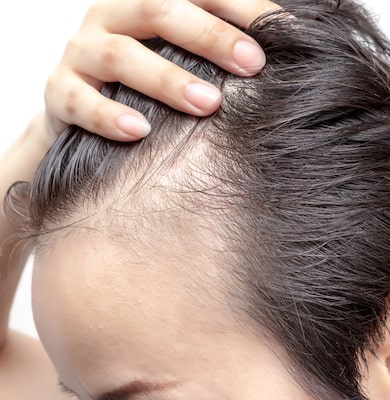 When a person is feeling a great deal of stress, the adrenal glands produce a hormone that is known as cortisol, The stress can make the cortisol signal the hair follicles to shift out of the growth phase and into catagen (which can be described as a transition phase). This shift can result in the hair falling out and hair loss due to sudden stress is known as Telogen Effluvium.
When a person is feeling a great deal of stress, the adrenal glands produce a hormone that is known as cortisol, The stress can make the cortisol signal the hair follicles to shift out of the growth phase and into catagen (which can be described as a transition phase). This shift can result in the hair falling out and hair loss due to sudden stress is known as Telogen Effluvium.
It can be said that stress impacts everyone differently so it is important to understand that stress can be sudden and impactful or the results of stress on the hair can also be cumulative.
In order words, daily tasks and to-do lists can have a slow impact on the shedding of hair. On the hand, major or acute stress can result in a significant amount of hair loss due to an unexpected event or a traumatic injury. These types of events can cause a large shift in the neurochemical or hormonal balance of the body. The changes in stress hormones can send a signal that causes a large amount of hair follicles to prematurely change from the growth phase of hair (anagen) to the resting phase (telogen) of the hair growth cycle.
The loss of hair can occur as a thinning of the scalp hair that makes it have a weaker structure that can also be experienced as hair breakage.
Hair Loss Related to Stress – How to Prevent It
While it seems obvious to say that learning to reduce your stress by coping with stressful situations in different ways can reduce hair loss, it is true that this is a key element to combating hair loss due to stress.
If a stressful event has occurred, the diffuse hair loss will normally not be visible for anywhere from two to three weeks to two to three months. The hair loss can be seen as thinning hair on the scalp as well as the shedding of hair during routine hair care routines such as combing or shampooing the hair. Once the hair loss starts to become noticeable, patients should contact a doctor in order to address the loss of hair and to make a treatment plan to keep the existing hair on the scalp.
Once the cause of the shedding, also know the event producing enough stress to result in shedding, is no longer an active event or is no longer present in the life of a patient, the diffuse hair loss/shedding of the hair will start to slow done. It can even disappear completely, but this can take anywhere from six to eight months.
Hair Loss Related to Stress – Is Treatment Necessary for the Condition?
When it comes to the condition known as Telogen Effluvium, the hairs on the scalp that are lost during the shedding process are pushed out by new hair that is growing underneath them. In fact, the act of the hair falling out serves as a signal that the regrowth of hair has started for the patient. There might be times when the doctor will suspect that the hair loss is being caused by some sort of genetic deficiency or medication. However, Telogen Effluvium is normally considered to be a self-contained condition that will not require any further treatment on the part of the doctor.
The loss of hair can be caused by stress, genetics, or other factors such as a repeated pulling of the hair due to stress or OCD. It is important to contact an experienced and board-certified doctor who specializes in the treatment of hair loss. The doctor will examine the scalp to determine the current amount of hair loss and to also examine the scalp to identify the reason for the hair loss. It is also important for the doctor to gather more information about the medical history of the person to learn if the patient is genetically inclined to experience hair loss
Once the reason for the hair loss has been identified, as well as the extent of the loss of hair that has occurred on the scalp by the time of the office visit, the doctor can explain the reason for the loss of hair to the patient and make a plan to treat the scalp of the person.
Pattern Hair Loss Cure – New Molecule Might Hold the Key
The search for a way to prevent hair loss is ongoing as scientists try to identify a way to prevent pattern hair loss. Researchers at the University of California, Irvine (UCI), say they have identified a signaling molecule that is known as SCUBE3. The experiments conducted by the research team are said to have shown this signaling molecule has the potential to cure a type of hair loss that is prevalent in both male and female patients. It was reported that this chemical compound works to instruct hair stem cells to begin dividing. In turn, this can trigger new hair growth as shown by the results they viewed after the molecule was injected into human hair follicles that were grafted onto the skin of mice being examined by the researchers.
SCUBE3 – How it Signals Hair Growth
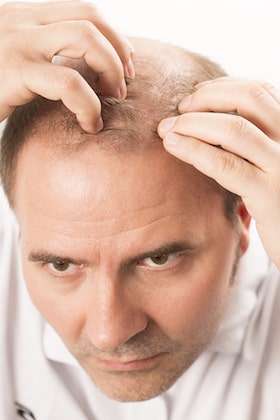 According to the researchers at UCI, SCUBE3 acts upon a cell population that is in the skin. This cell population is known as dermal papilla (DP) and these cells are known for the important role they play in the regulation of the development and growth of hair follicles. In addition, the significance of DP cells is also elevated by the fact that they are multi-potent stems cells which means they have the ability to self-renew by dividing and developing into various specialized cell types that are found in multiple organs and tissues in the body.
According to the researchers at UCI, SCUBE3 acts upon a cell population that is in the skin. This cell population is known as dermal papilla (DP) and these cells are known for the important role they play in the regulation of the development and growth of hair follicles. In addition, the significance of DP cells is also elevated by the fact that they are multi-potent stems cells which means they have the ability to self-renew by dividing and developing into various specialized cell types that are found in multiple organs and tissues in the body.
When it comes to people who are experiencing androgenetic alopecia, which is also known as male pattern baldness in male patients, the DP cells can begin to malfunction due to factors related to genetics. This hair loss condition is characterized by the progressive loss of hair on the scalp of the person. Females can also experience androgenetic alopecia, but this condition follows a different distribution pattern depending on the gender of the person. For example, male patients tend to show a prominent level of hair loss in the front of their scalp. On the other hand, female patients tend to show a diffuse type of hair loss that occurs on the top of the head and on the crown of the head.
Hair Loss Research Discusses the Role of Chemical Activation and Hair Growth
The research team at UCI suspects that the activation of chemicals is a step that must be involved in the proliferation of DP cells. To learn more about this theory, the researchers bred mice with a good amount of hair. They used hyperactivated dermal papilla cells on any mechanisms that are part of the hair growth regulation process so they would be easier to observe. Upon looking closely at the mice and the results, the SCUBE3 signaling molecule (which was previously unknown) began to appear.
According to Maksim Plikus, UCI professor of developmental and cell biology as well as the corresponding author of the study that was presented in the journal Developmental Cell, “At different times during the hair follicle life cycle, the very same dermal papilla cells can send signals that either keep follicles dormant or trigger new hair growth. We revealed that the SCUBE3 signaling molecule, which dermal papilla cells produce naturally, is the messenger used to ‘tell’ the neighboring hair stem cells to start dividing, which heralds the onset of new hair growth.”
SCUBE3 and Hair Growth – How it Works
In order to view exactly how SCUBE3 promotes the growth of hair, the research team injected SCUBE3 into the skin of mice in which human scalp follicles had already been transplanted. The researchers observed that new hair shafts began to grow from the bald patches, made up of human follicles, that were dormant. In addition, the surrounding mouse follicles were also activated, and they began to grow more hair than was normally seen in the past.
It should be noted that, in both humans and mice, the dermal papilla cells must produce activating chemicals in order to effectively develop hair. If a person has androgenetic alopecia, their dermal papilla cells malfunction, and this lowers what is normally a plentiful amount of activating chemicals. Studying the mouse model with excessive hair and hyperactivated DP cells allowed the researchers to identify SCUBE3 as the signaling molecule that was previously unknown when it came to an excessive amount of hair growth.
These results suggest that SCUBE3 might be a future treatment option for hair loss. As of the writing of this blog, there are only two medications that are approved by the FDA for sale in the United States to treat androgenetic alopecia. These two medications are minoxidil and finasteride and they both have to be taken on a consistent and ongoing basis to achieve and maintain results related to the regrowth of hair on the scalp.
Plikus noted, “There is a strong need for new, effective, hair loss medicines, and naturally occurring compounds that are normally used by the dermal papilla cells present ideal next-generation candidates for treatment. Our test in the human hair transplant model validates the preclinical potential of SCUBE3.”
The research team has filed for a patent regarding the use of SCUBE3 as a therapeutic agent for androgenetic alopecia. They hope to begin clinical trials on human subjects in the near future.
National Hair Loss Awareness Month – What This Means for Patients
August is here and the arrival of this month is usually thought of as the end of summer vacation for students, teachers, and parents. There is another group of people who know the month of August is also known as National Hair Loss Awareness Month. This yearly spotlight on the topic of hair loss informs the public that hair loss can impact both male and female patients and it also gives people more information about how to combat the loss of hair though procedures such as a hair transplant.
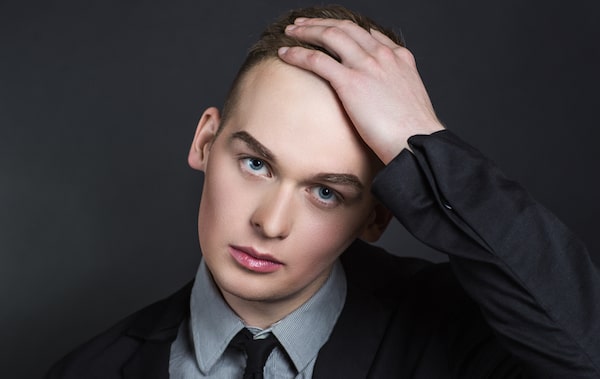
National Hair Loss Awareness Month – Building Awareness of the Condition
There are a number of reasons that people start to experience thinning hair that can lead to a loss of hair on multiple areas of the scalp. Some of the factors that can result in hair loss include genetics, medications, wearing the hair in such a way that it causes the hair to be pulled in a repetitive manner in a certain section of the scalp, sudden stress, trauma to the hair/scalp, and medical treatments (such as chemotherapy).
Due to the multiple reasons for hair loss, as well as questions on the part of patients, the American Academy of Dermatology declared August as the month to increase awareness about the condition of hair loss. The goal of the month is to share information about hair loss as there are still some people who are embarrassed by the loss of hair on their scalp, and they are also too embarrassed to discuss it with a doctor. The August spotlight provides patient education and also exposes the public to medical treatment options they might not have known existed for them. In addition, it shows the public they are not alone in experiencing hair loss and there are people they can reach out to for help and more information.
National Hair Loss Awareness Month – Steps the Public Can Take in August
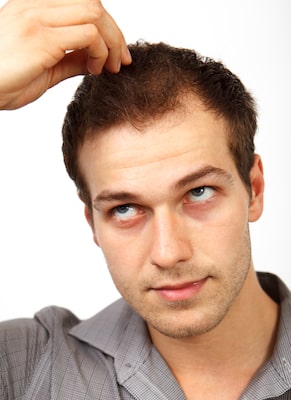 The quest for a permanent cure for hair loss stretches all the way back to the beginning of recorded history. The history books are filled with stories of people using wigs, herbal solutions, lasers, UV instruments, and other options to combat the loss of hair on the scalp. The desire to address hair loss has always been important to the public as the appearance of a full head of hair can often give a person a younger and stronger look. A healthy hairline also plays a part in providing a positive self-image and making a person feel confident about their appearance.
The quest for a permanent cure for hair loss stretches all the way back to the beginning of recorded history. The history books are filled with stories of people using wigs, herbal solutions, lasers, UV instruments, and other options to combat the loss of hair on the scalp. The desire to address hair loss has always been important to the public as the appearance of a full head of hair can often give a person a younger and stronger look. A healthy hairline also plays a part in providing a positive self-image and making a person feel confident about their appearance.
One of the easiest ways to observe National Hair Loss Awareness Month is to conduct research about the topic. Patients can schedule a consultation appointment with a board-certified hair transplant surgeon, or they can read informative articles (such as this one) that will lead them to additional information on websites (such as this one) filled with accurate and timely information about hair restoration options. The more information a person gains about the hair restoration process, including treatment options such as a hair transplant or minoxidil and finasteride, the better educated the person will be when deciding how to address their hair loss.
The loss of hair on the scalp can begin at almost any age as a person starts to enter adulthood and this can also include the late teens or early twenties of a patient. On the other hand, a person might be in their fifties or sixties before they begin to lose their hair. The amount of hair loss, the reason for the hair loss, and the time it takes to start to become noticeable varies per person so education about the hair loss process is a large part of the event spotlight during the month of August.
The issue of hair loss has been around for a very long time and deciding to not silently accept the loss of hair on the scalp can be a first step to take during the month of August. The decision to openly talk about the current condition of the scalp can actually be quite liberating for a person and help them to stop avoiding the issue and start taking active steps to address and resolve the issue.
While August is a spotlight month for the issue of hair loss, this is a medical condition that we address each and every month at Parsa Mohebi Hair Restoration. Our experienced team of surgeons knows that many people define their appearance by the hair on their head and they want to retain the look of a healthy head of hair on their scalp. Our board-certified surgeons perform a complete examination of the scalp in order to determine the reason for the hair loss. They also take the time to explain the hair restoration process to patients and to explain their treatment options. Anyone interested in learning more about hair loss in August (or any other month) is invited to contact our office today for more information and to schedule a consultation appointment with one of our experienced surgeons.
Hair Like Mickey Mouse – Get the Details
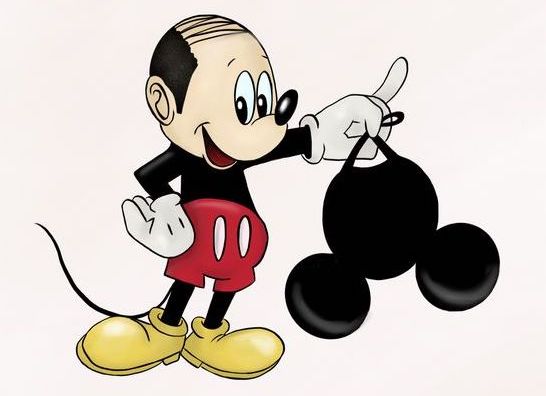
It is no exaggeration to say that Mickey Mouse is one of the most beloved cartoon characters of all time. From his appearances in cartoons and TV shows to his starring role at the Disney theme parks, it is safe to say that people of all ages love Mickey Mouse.
Except for the people with a hairstyle that is starting to resemble the top of Mickey’s head.
Let’s take a look at how the hairline can start to resemble Mickey Mouse (yes, it is a real thing) and what can be done to improve the hairline of the person experiencing hair loss.
Mickey Mouse Hairline – What is it?
The hairline resemblance to Walt Disney’s most famous creation, which is known as the “Mickey Mouse Hair Effect,” did not gain that name simply because people thought it was a funny idea. The name describes a hereditary balding condition that starts by impacting both sides of the frontal hairline. The area of balding on the scalp will start to progress in an upward manner and it results in a look to the scalp that is similar to the head of Mickey Mouse.
While Mickey Mouse is meant to be funny and laughed at by the public, the people who experience balding do not find the look that it gives to the scalp something they find amusing.
The image suggests that Mickey is secretly bald, and he hides this from the public under mouse ears that are detachable. Once the mouse ears are removed, Mickey is revealed to have thinning hair that he styles in a way that is easy to hide under his mouse ears.
While there are some people who accept the image as the joke it is intended to be, there are others who think this is true as well as some people who get angry at the suggestion that their favorite mouse is going bald.
No matter what a balding person thinks about the image, once they start to have a hairline that looks like Mickey Mouse, what is the next step they can take to address the hair loss on their scalp?
(Not So) Spoiler Alert – They can inquire about undergoing a hair transplant!
Hair Transplant – What is Involved in the Process?
A hair transplant is when a surgeon moves hair follicles from the donor area of the scalp (usually the back and sides of the scalp) to the areas of the scalp where hair loss is occurring. If there is not enough high-quality donor hair available in the donor area of the scalp, the surgeon can use hair grafts from other areas of the body such as the beard, torso, and extremities.
These hair grafts are harvested by the surgeon and transplanted in naturally occurring groupings (of follicular units) to provide the baling area with hair that is natural in appearance.
The most popular method of harvesting hair from the donor area is through Follicular Unit Extraction (FUE). During an FUE procedure, the surgeon will individually harvest the hair grafts using microscopic techniques. Thanks to the individual removal of the hair grafts, there is no need for the surgeon to create a linear incision on the scalp (which means there is not a linear scar after the procedure). The surgeon will create tiny incisions in the targeted balding area so the follicular units can be transplanted into the scalp. The follicular units are also distributed in the scalp in such a way that the appearance of the hair will be natural in appearance and undetectable to the average eye.
The transplanted hair follicles will become part of the scalp within a few days of them being transplanted and implanted by the surgeon. Once the hair grafts are implanted into the scalp, the appearance of stubble will occur as well as the appearance of some scabbing in the transplanted area. (FYI: This scabbing will start to fall out on its own after a few weeks because the hair will enter the resting phase of the hair growth process.)
Several months after the hair grafts enter the resting phase, they will enter the growth phase and start to grow until they eventually become normal, mature hair. The transplanted hair will be resistant to the balding process even though it is placed in the (formerly) balding area of the scalp.
The hair that grows after a hair transplant is permanent and this means a person who had a head that resembled the scalp of Mickey Mouse will not look like the mouse anymore. In other words, the patient will be able to enjoy watching Mickey Mouse on TV without having to worry about having an appearance like the mouse.
Crohn’s and Hair Loss – Learn the Connection
People who suffer from Crohn’s disease experience chronic inflammation in the gastrointestinal (GI) tract since the condition is an inflammatory bowel disease. The inflammation can result in symptoms such as pain, loss of weight and severe diarrhea. In addition, the inflammation can also appear in areas such as the skin and joints. While these symptoms are well-known by the public, it seems that hair loss is also one of the symptoms.
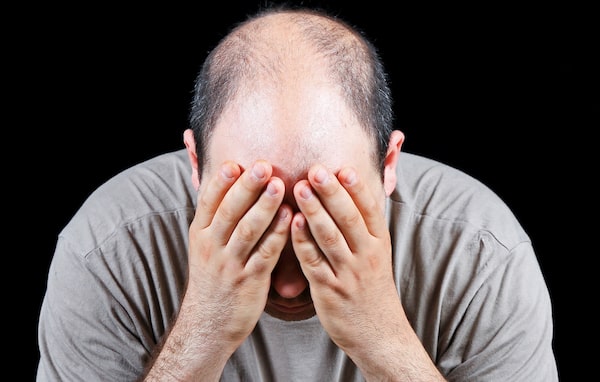
Hair Loss and Crohn’s Disease – How They are Connected
A research review from 2021 suggests there is a connection between inflammatory bowel disease and alopecia areata. This review also suggests the loss of hair might be a more common occurrence in people with inflammatory bowl disease than the general population.
In addition, a 2015 study showed 33% of the study participants reported hair loss as being a symptom of their bowel disease. However, the researchers were not able to prove whether or not each of those hair loss cases were related to inflammatory bowel disease which means the actual percentage has a chance of being smaller than the percentage reported in the study. One of the reasons the researchers were not able to provide a definitive answer is the fact that there are multiple factors that contribute to hair loss. This made it harder to determine whether the hair loss was the result of Crohn’s disease.
Having said that, let’s look at some of the connections between the loss of hair and Crohn’s disease.
Alopecia Areata and Crohn’s Disease
As mentioned above, the 2021 study suggests a link between Crohn’s and alopecia areata which is an autoimmune condition. In an autoimmune condition, the immune system mistakenly attacks the body of the person with the condition. When it comes to alopecia areata, the immune system attacks the hair follicles of the person. Hair follicles that suffer from alopecia areata will fall out and this results in hair loss that is visible as patchy, circular areas on the scalp that are about the size of a coin.
Further research is being conducted on the connection between Crohn’s disease and alopecia areata.
Telogen Effluvium and Crohn’s Disease
In general, telogen effluvium is a thinning condition that can be the result of sudden stress that leads to hair loss. Examples of sudden stress that lead to this type of hair loss include the stress of having surgery or giving birth. Another type of stress that can fall into this category is a flare of the symptoms that are related to Crohn’s disease.
If the Crohn’s disease symptoms are successfully managed to the point that the flare lessens in nature, the hair should begin to grow back on the scalp.
It is not completely understood yet just how prevalent telogen effluvium is in people who have Crohn’s disease, but researchers have associated telogen effluvium with Crohn’ s as well as autoimmune disease overall.
Hair Loss Medications and Crohn’s Disease – Is There a Connection?
There are some cases where hair loss could be a side effect to a medication known as methotrexate. According to the Arthritis Foundation, this medication is the Crohn’s medication that is most often associated with the loss of hair on the scalp. The medication fights inflammation by interfering with the growth of cells. In addition, it has been shown to interfere with hair follicle growth and this can result in some loss of hair on the scalp.
Hair Loss and Crohn’s Disease – Possible Solutions
Crohn’s patients who are experiencing thinning hair or balding on the scalp should contact their doctor to learn more about possible solutions for the issue. One of the most common solutions is adjusting the dosage of medicine the patient is taking and perhaps even the type of medication.
The scalp should also be examined by a board-certified doctor who is experienced in identifying the reasons for hair loss as well as devising treatment plans to address and reverse the issue of hair loss. The doctor can discuss the reasons for the hair loss and provide the patient with an action plan to treat the loss of hair on the scalp.
Some patients might be ideal candidates for oral or topical medications that can help to stimulate the growth of hair and these medications include minoxidil and finasteride. Patients do need to be aware of the fact the results gained from minoxidil, and finasteride will only last as long as the medication is used by the person on a regular basis. These medications require a lifetime commitment as any gains made from their use will start to disappear once they are not used on an ongoing basis.
The ideal treatment for the loss of hair might be a hair transplant. The surgeon will take donor hair (usually from the back and sides of the scalp) and transplant the hair grafts into the area of the scalp where the hair loss has occurred. A hair transplant is a permanent hair loss solution, and the final results are natural in appearance.
Hair Loss and Diabetes is there a Connection?
Hair loss as a possible side effect of diabetes is rarely discussed. Most likely because of the other more damaging side effects, like the risk of losing eyesight or damaged nerves. And the loss of hair may seem less significant or viewed as a vanity issue.
Diabetes is a chronic disease that can cause elevated blood sugar (glucose) levels to occur in the body. Excess sugar in the blood can damage vital organs such as the heart, kidney, eyes, skin, and hair follicles. When there are high glucose levels in the blood, small blood vessels are damaged, causing a lack of oxygen needed to help nourish organs and tissue in the body.
The skin is the body’s largest organ. Hair and nails derive from the skin making up the integumentary system. For this system to work correctly, it needs blood rich in oxygen and nutrients. People living with diabetes have a higher risk of damaged blood cells, disturbing hair growth, which could lead to hair loss.
Damaged blood vessels and improper blood flow related to having diabetes are some of the possible theories and causes that could lead to hair loss associated with having diabetes.
In this article, we will share the possible causes of hair loss and diabetes and uncover ways to restore hair loss.
Which Type of Diabetes may be related to Hair Loss?
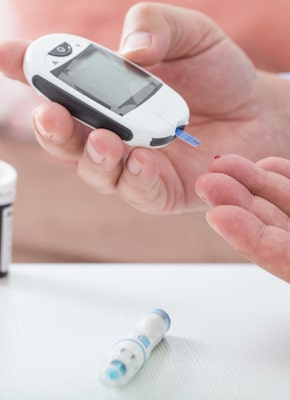 There are two types of diabetes- type 1 and type 2. Both types of diabetes are diseases that affect the way a person regulates blood sugar or glucose. Glucose is needed to fuel a body’s cells and to create energy. The body needs insulin to help regulate blood sugar levels, but both types of diabetes have challenges producing insulin for the body.
There are two types of diabetes- type 1 and type 2. Both types of diabetes are diseases that affect the way a person regulates blood sugar or glucose. Glucose is needed to fuel a body’s cells and to create energy. The body needs insulin to help regulate blood sugar levels, but both types of diabetes have challenges producing insulin for the body.
People with type 1 diabetes can’t produce insulin because their immune system attacks the cells that make it.
People with type 2 diabetes resist the insulin produced by the body, meaning the body doesn’t properly use insulin to help regulate blood sugar levels.
Both types of diabetes lead to chronically high blood sugar levels in different ways. One is a deficiency with the immune system, and the other absorption of blood sugar by cells, causing abnormal spikes.
In theory, high blood sugar levels can lead to damaged blood vessels, and without healthy oxygen-rich blood vessels, your body cannot nourish vital organs, such as your skin and hair follicles.
It has been reported that some types of hair loss conditions are more associated with specific types of diabetes.
Alopecia and Diabetes- Is There a Connection?
Among all types of hair loss conditions, there have been studies and reports associating diabetes with androgenetic alopecia and alopecia areata. Each kind of alopecia affects the hair in different ways.
Androgenetic Alopecia
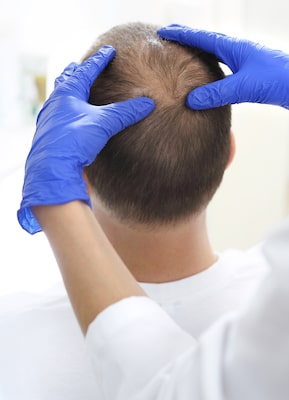 Androgenetic alopecia or male pattern baldness is the miniaturization of hair follicles due to their sensitivity to one type of male hormone called dihydrotestosterone (DHT). Women can also be affected by androgenetic alopecia. However, the type of baldness in women is different from that of men. Thinning hair in women can start at the top of the head, from the parting line. Elevated levels of DHT in hair follicles and blood can cause a shorter hair growth cycle and can change the characteristics of the strands thinner.
Androgenetic alopecia or male pattern baldness is the miniaturization of hair follicles due to their sensitivity to one type of male hormone called dihydrotestosterone (DHT). Women can also be affected by androgenetic alopecia. However, the type of baldness in women is different from that of men. Thinning hair in women can start at the top of the head, from the parting line. Elevated levels of DHT in hair follicles and blood can cause a shorter hair growth cycle and can change the characteristics of the strands thinner.
People suffering from androgenetic alopecia are typically prescribed FDA-approved medication such as minoxidil or finasteride. Both medications can take months to start seeing the appearance of hair due to the slow growth of hair follicles. However, severe cases of androgenetic alopecia may not be reversed by medical treatment, and other treatments such as a hair transplant may be required.
Studies have been conducted associating androgenetic alopecia with metabolic syndrome, a collection of conditions including high blood sugar related to type 2 diabetes.
Alopecia Areata
Alopecia areata is an autoimmune disease in which your immune system attacks the hair follicles, delaying the cycle of hair growth that can lead to hair loss. Unlike the hair loss pattern from androgenetic alopecia, hair loss with alopecia areata is usually patchy, coin-shaped, and limited to small areas. Alopecia areata is typically a self-recovering condition, meaning hair follicles affected by the disease can regrow with no intervention, and a patient can see hair growth within a few months from the beginning of hair loss.
If a patient does not have a full recovery in a few months, more aggressive treatments might be needed, such as local injections of corticosteroids.
People living with diabetes also have been associated with alopecia areata. This association has been more clearly describing with patient with diabetes type I. These patients may present with the more severe types of alopecia areata that involves hair follicles in the entire body aka alopecia Universalis.
Can Your Hair Grow Back After Hair Loss from Diabetes?
If you are a person living with diabetes and suffering from hair loss, consult with a hair specialist who can examine your hair and scalp to confirm the diagnosis. If you have diabetes and your doctor determines that it affects your hair, the essential step for hair recovery is to manage your blood sugar levels. Managing your diabetes and getting it under control with a combination of medications, a healthy diet, and exercise can help support the healthy blood flow your scalp needs to promote hair growth.
Suppose you meet your diabetes goal, maintain your glucose levels consistently, and still suffer from hair loss. In that case, your doctor may need to evaluate the other possibilities and to help rule out any other underlying causes.
Other Ways to Restore Your Hair
If you have met all of your requirements to control your diabetes and are not receptive to taking medication to address the hair loss, then a consultation for a hair transplant may be indicated.
A hair transplant involves harvesting more permanent hair follicles from a donor area, such as the back or sides of the head, and implanting them in the balding areas. The results are considered to be lifelong if the donor’s hair is appropriately selected.
The Final Takeaway
Diabetes is a chronic disease that can have a wide range of side effects on the entire body, and hair loss associated with diabetes should not be ruled out, even though there isn’t a definitive correlation. If you have noticed abnormal hair loss and are diabetic, make sure to consult with your doctor for a complete diagnosis.
Weight Loss and Hair Loss – Find Out if They are Related
Hair loss can occur for a number of reasons including genetics and medical conditions. There are also some cases where weight loss can lead to hair loss as one of its side effects. The body is sensitive to stress and changes in the hormones which can happen as result of weight loss surgery, a rapid amount of weight loss and even a restrictive diet. Let’s take a look at why some people experience a loss of hair on the scalp after they lose weight as well as ways to address the issue.
Hair Loss after Weight Loss – A Closer Look at the Reasons it Occurs
The loss of hair on the scalp during weight loss is commonly caused by deficiencies in essential nutrients. For example, restrictive diets and sudden amounts of weight loss have been linked to acute Telogen Effluvium (TE) which is when stress forces a large amount of hair roots to move into resting stage prematurely. Some of the causes of this condition include thyroid issues, childbirth, major levels of psychological stress and medications such as antidepressants. The hair on the scalp can return once the cause of the shedding of the hair (the event producing the stress) is no longer active or present in the life of the person. Nutrition deficiencies and weight loss have also been linked to patients suffering from alopecia.
How Diets Can Lead to Hair Loss
 There have been studies about the connection between hair loss and crash dieting that go back to the 1970s. In general, the hair on the scalp requires an adequate amount of nutrients and calories to grow properly. If the body does not receive the proper number of calories and nutrients, a person can experience side effects such as hair loss.
There have been studies about the connection between hair loss and crash dieting that go back to the 1970s. In general, the hair on the scalp requires an adequate amount of nutrients and calories to grow properly. If the body does not receive the proper number of calories and nutrients, a person can experience side effects such as hair loss.
An example includes a 2015 study of 180 women who were experiencing diffuse hair loss. The study found that the most common cause of the hair loss on the scalp were psychological stress and iron deficiency. Eight of the cases showed that crash diets were the reason for the hair loss in the women taking part in the study.
In addition, a poorly planned diet can result in deficiencies in the recommended daily amount of calories along with deficiencies in the amount of protein that helps hair growth. Amino acids, which are the building blocks of protein, are an essential part of the hair growth process. Amino acids are important because they are needed for the production of keratin (which is the main structural protein found in hair). If the body of a person does not get enough protein, this is known as protein malnutrition, and it can result in a loss of hair. This is why a person that is following a crash diet and/or a low-calorie diet that does not contain enough protein can experience hair loss.
If the amount of protein needed by the body is not being provided, the body will begin to prioritize functions of the body that are dependent on protein such as tissue repair, production of hormones and proper digestion. Since the growth of hair is not considered by the body to be a task that keeps a person alive, a patient might begin to experience hair loss.
Weight Loss Surgery and How it Can Result in Hair Loss
In general, weight loss surgery has been associated with a rapid amount of weight loss in patients. It has also been known to cause a deficiency in minerals, protein and vitamins that help with hair growth. If the amount of protein, minerals and vitamins are found to be lacking, a person can experience hair loss.
A 2020 study of 112 women, who had sleeve gastrectomy surgery, showed that the patients had experienced some level of hair loss after their procedure. In 79% of the patients who said they had experienced hair loss after the surgery, they said the loss of hair on the scalp began around three or four months after the surgery. They also said that the hair loss lasted for an average length of 5.5 months.
How to Avoid Hair Loss after Weight Loss
The first step in avoiding hair loss, while still being able to enjoy weight loss, is to follow a healthy and well-balanced diet. Planning ahead and making sure diet contains enough nutrients and proteins to keep the body healthy is a key element in preventing hair loss form occurring during a diet.
In addition, patients that are not sure if their diet will be able to prevent side effects like a loss of hair on the scalp should consult with their doctor before starting their weight loss plan. The doctor will be able to review the planned diet with the person in order to make sure it is not a crash diet or any kind of plan that will have a negative impact on their overall health and appearance.
– MA